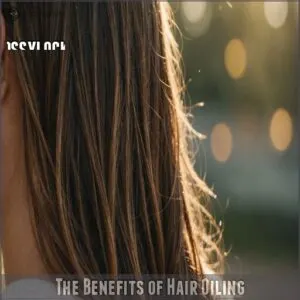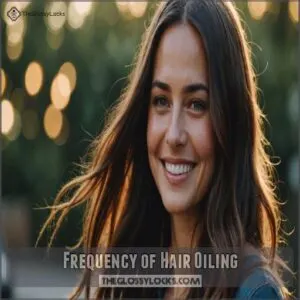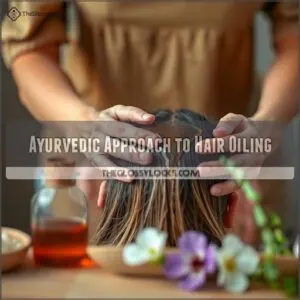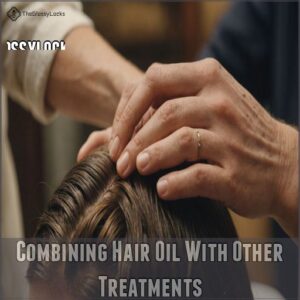This site is supported by our readers. We may earn a commission, at no cost to you, if you purchase through links.
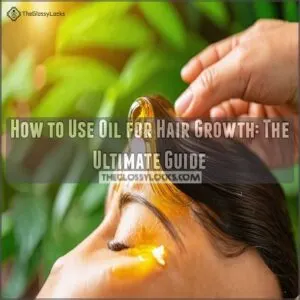
Start by choosing an oil that suits your hair type—coconut oil is great for dry curls, while rosemary oil can stimulate hair growth.
Clean your scalp first, then massage the oil in circular motions to boost blood circulation and wake up those follicles.
Let it soak for at least 30 minutes before rinsing.
Some folks enjoy leaving it overnight, turning into a greasy masterpiece, but that’s optional!
Remember, your hair will thank you for the love.
Curious about how often you should oil or the benefits of a scalp massage?
Stick around for more insights!
Table Of Contents
- Key Takeaways
- Choosing The Right Hair Oil
- The Benefits of Hair Oiling
- How to Apply Hair Oil
- The Role of Massaging in Hair Growth
- Rosemary Oil for Hair Growth
- Frequency of Hair Oiling
- Ayurvedic Approach to Hair Oiling
- Combining Hair Oil With Other Treatments
- Common Mistakes to Avoid
- Monitoring Progress and Adjusting Your Routine
- Frequently Asked Questions (FAQs)
- How do you use a hair oil for hair growth?
- Does massaging the head and using an essential oil help with hair growth?
- Do you need a hair growth oil?
- Do hair oils cause hair growth?
- How do I apply oil to my hair for growth?
- How often should I oil my hair for hair growth?
- What is the proper way to use hair oil?
- Does oil really help hair growth?
- How long should hair oil be left in?
- Can hair oil cause scalp irritation?
- Are there oils safe for colored hair?
- What oils suit sensitive scalps best?
- Does oiling impact hair texture?
- Conclusion
Key Takeaways
- Choose oils based on your hair type, and consider incorporating pumpkin seed oil, a nutrient-rich product that may help improve the look and feel of your hair with best pumpkin seed oil for hair; coconut oil can quench dry curls, while rosemary oil stimulates hair growth and boosts circulation.
- Consistently apply hair oil at least twice a week for optimal growth, massaging your scalp in circular motions to enhance absorption and blood flow.
- For added benefits, let the oil soak in your hair for at least 30 minutes or overnight to deeply nourish and strengthen strands.
- Avoid over-oiling and ensure regular scalp exfoliation to prevent buildup and maintain a healthy scalp environment.
Choosing The Right Hair Oil
Choosing the right hair oil can feel like picking a new pair of shoes—what works wonders for one person mightn’t fit another.
To get the best results, consider your hair type and needs, whether it’s taming frizz with coconut oil or boosting growth with rosemary oil.
Understanding Your Hair Type
Understanding your hair type is the first step in choosing the right hair oil.
Identifying your hair texture, porosity, curl pattern, and density helps tailor your hair care routine.
If your curls bounce like springs, they’re high porosity, needing extra moisture.
Straight strands? Low porosity might mean oils absorb slowly.
Your scalp health matters too, as a healthy scalp, nourished with natural products like ghee for hair care, promotes hair growth and vibrant follicles.
Consider your hair’s unique needs—like how it feels after a wash or on humid days.
Knowing your hair type makes sure you’re in control, giving your strands the best care possible.
Selecting The Best Oil for Your Needs
Picking the perfect hair oil is like matchmaking for your strands, balancing hair type, budgets, and goals.
Got dry curls? Moisturizing oils like coconut can quench that thirst.
If you’re weighing options between two popular choices, consider the benefits of almond oil vs coconut oil for hair.
If scalp health is your aim, tea tree oil fights dandruff, while rosemary oil might boost hair growth.
Aim for something that tackles hair loss or shedding? Jojoba oil is your sidekick.
Consider your scalp condition too—sensitive scalps benefit from gentle oils.
Remember, luxurious oils don’t have to break the bank. Balance benefits and costs; your ideal hair oil is out there waiting to pamper those locks!
The Benefits of Hair Oiling
When you oil your hair, you’re not just keeping it shiny; you’re protecting it from damage and encouraging growth.
Experts affirm that using olive oil for hair growth, a natural remedy rich in antioxidants and essential fatty acids olive oil benefits, can improve scalp health, reduce hair loss, and provide the essential nutrients your hair needs.
How Hair Oiling Promotes Hair Growth
Ever wonder how hair oiling revs up hair growth?
It’s mystical yet simple.
First, it nourishes your scalp, a key to hair health.
Second, hair oil enhances oil absorption, moisturizing the hair shaft.
Third, incorporating an oiling routine can debunk hair growth myths.
Remember, using key hair oil ingredients could transform your hair growth journey!
Reducing Hair Loss and Damage
While hair oiling boosts growth, it tackles hair loss and damage, too.
By preventing breakage and repairing damaged locks, oils like tea tree soothe and strengthen, lessening issues like androgenic alopecia.
Regularly massaging oils into your strands can create a barrier against damage.
Picture it as a cozy blanket for your hair, wrapping it in care and protection.
Improving Scalp Health
Healthy hair starts with a healthy scalp.
Regular oiling, like with rosemary oil, nourishes your scalp, reducing inflammation and dandruff.
Gentle scalp massage techniques improve circulation, promoting hair follicle health.
Think of it as a spa day for your scalp!
Scalp exfoliation can also remove buildup, preventing seborrheic dermatitis.
Using the right scalp health products and maintaining good scalp hygiene are key.
Remember consistent hair oil application is important for best results.
How to Apply Hair Oil
To apply hair oil effectively, start by using it as a pre-shampoo treatment, letting it sit for about ten minutes to prep your hair for cleansing.
After washing, apply a small amount from roots to ends, and if you’re using essential oils, always mix a few drops with a carrier oil to protect your scalp.
Pre-Shampoo Treatment
Start your pre-shampoo treatment by picking the right hair oil.
Here’s how:
- Choose your oil type carefully. Go for moisturizing oils like coconut for dry hair or rosemary to promote hair growth.
- Apply generously. Massage from roots to ends.
- Let it sit. Leave it for about 10 minutes before rinsing.
Post-Shampoo Application
After shampooing, apply hair oil to seal in moisture and boost hair growth.
Focus on the ends to control frizz and facilitate easy detangling.
With your hair still damp, work a small amount of oil through.
Choose a lightweight oil for fine hair or a richer oil for thicker locks.
It’s like a soothing balm for your hair.
| Hair Type | Recommended Oil | Benefits |
|---|---|---|
| Fine | Argan | Lightweight, non-greasy |
| Curly | Coconut | Nourishes, reduces frizz |
| Thick | Castor | Deep moisture, shine |
Using Essential Oils With a Carrier Oil
You’ve finished your post-shampoo rituals. Now, it’s time for a little magic with essential oils. Mix a few drops with a carrier oil for a DIY hair elixir that’s both safe and effective.
Here’s why it works:
- Dilution ratios are essential for safety.
- Essential oil blends can boost hair growth.
- Carrier oil benefits include nourishment and reduced irritation.
The Role of Massaging in Hair Growth
When you massage oil into your scalp, you’re not just pampering yourself; you’re also boosting blood circulation, which can help stimulate hair follicles.
Science suggests that regular scalp massages can enhance hair growth and even reduce stress, making your haircare routine a win-win.
Increasing Blood Circulation
Applying oil is just the beginning; let’s boost your hair health by enhancing blood flow.
Massaging promotes circulation benefits and tension relief, stimulating growth naturally.
Using coconut or castor oil, you can help prevent hair thinning and scalp infection.
Here’s a quick guide:
| Technique | Benefits |
|---|---|
| Circular Massage | Blood Flow & Hair Health |
| Fingertip Pressure | Tension Relief |
| Weekly Routine | Hair Growth Stimulation |
| Relaxing Environment | Stress Reduction |
Stimulating Hair Follicles
Gentle scalp massage directly stimulates hair follicles.
A few minutes of this can make a big difference!
Here’s why:
- Improved blood flow nourishes follicles.
- It helps distribute hair oil, promoting follicle health.
- Massage can loosen dead skin cells, preventing clogged follicles.
- It’s a relaxing ritual that contributes to overall well-being, and nourishing the scalp with curry leaves oil benefits, indirectly benefiting hair growth.
Regular scalp massage, combined with the right hair oil, can greatly improve your hair growth journey.
Reducing Stress and Tension
Picture stress melting away as you indulge in a soothing scalp massage.
This simple act can do wonders beyond hair health, like easing tension headaches and promoting mindfulness.
By combining massage with the benefits of aromatherapy oils, you address both mind and body.
It’s not just about hair oil advice; it’s your go-to method for stress relief and wellness.
Rosemary Oil for Hair Growth
You might be surprised to learn that rosemary oil isn’t just a kitchen staple but also a scientifically-backed option for boosting hair growth.
Researchers have found its compounds can stimulate hair follicles and improve circulation, leading to healthier, thicker hair when used consistently.
What Makes Rosemary Oil Effective
Having just explored how massaging improves hair growth, let’s talk rosemary oil’s magic. This aromatic oil shines in the hair care world because of its ability to boost blood circulation to the scalp.
Black seed oil, rich in thymoquinone, can help reduce inflammation around hair follicles, Enhanced circulation nourishes hair follicles, promoting growth and reducing hair loss.
Armed with potent antioxidants, rosemary oil prevents hair breakage and adds a radiant shine, making it a must-have ally.
Other Benefits of Rosemary Oil
Beyond hair growth, rosemary oil offers other perks.
It’s your ally for scalp health, tackling dandruff and improving overall texture.
This oil can enhance hair shine and even maintain color vibrancy.
For those on guard against premature graying, rosemary’s antioxidant properties come to the rescue.
Make it a staple in your routine for a naturally healthy mane.
How to Use Rosemary Oil for Hair Growth
Rosemary oil isn’t just for its scent; it’s a hair growth champion.
To use it effectively:
- Dilute: Mix a few drops with a carrier oil, like jojoba, to avoid side effects.
- Apply: Massage into your scalp to stimulate follicles.
- Rinse: Leave it on for about 30 minutes before rinsing with shampoo.
Frequency of Hair Oiling
Determining how often to oil your hair can be a bit like choosing between your favorite snacks—it’s all about finding the right balance.
Experts suggest oiling your hair at least twice a week for best growth, but always consider your hair type and lifestyle to fine-tune that routine.
How Often to Oil for Hair Growth
The ideal hair oiling frequency depends on your hair type and scalp health.
For fine hair, once a week might suffice, focusing on the scalp.
Those with thicker, curlier hair may benefit from daily oiling.
You should note that the frequency of scalp oiling depends on hair and scalp condition, with dry or damaged hair possibly requiring oiling once or twice a week.
Listen to your hair; if you notice buildup or greasiness, reduce the frequency.
A hair oil expert can provide personalized advice.
Remember, consistency is key, but don’t be afraid to adjust your routine!
Leaving Oil Overnight
Got a big day tomorrow and not sure about your hair oiling schedule?
Leaving oil overnight can be your golden ticket to healthier hair.
Consider using a product like Restovi Hair Growth Oil available online for hair growth. It provides deeper nourishment and fosters growth.
However, guard against using too much and facing greasy sheets.
Consider green tea or saw palmetto oil for added benefits, including carnosic to stimulate growth.
Alternative Methods for Busy Schedules
Busy life got you in a knot? Quick hair oiling can fit into any hectic schedule. Here’s how you can do it:
- Dry shampoo keeps roots fresh.
- Hair oil spray offers a quick shine.
- Pre-wash oil before a shower saves time.
- Short oil sessions still nourish hair.
- Weekly deep oil sessions can replace daily care.
Ayurvedic Approach to Hair Oiling
In the Ayurvedic approach to hair oiling, you’ll tailor your routine to your unique dosha, which is believed to influence your hair’s texture and health.
By choosing oils and herbs that align with your dosha, like using sesame oil for vata hair, you can promote hair growth and maintain scalp health effectively.
Understanding Your Dosha
Understanding your dosha is like decoding your hair’s personality in Ayurveda.
Your dosha types—Vata, Pitta, or Kapha—dictate your hair’s behavior.
To address hair loss holistically, it’s important to balance the three doshas, which can be achieved through Ayurvedic hair growth practices.
Vata hair often feels dry and frizzy, Pitta hair leans towards a mix of oily and dry, while Kapha hair typically embodies thickness and oiliness.
Balancing your dosha helps maintain vibrant, healthy hair.
Choosing The Right Oil for Your Dosha
You’ve pinpointed your dosha—now it’s time to match it with the right Ayurvedic hair oils.
Your mane’s unique needs depend on your dosha’s traits.
- Vata hair types: Go for nourishing sesame oil to combat dryness.
- Pitta hair types: Cooling coconut oil can soothe your scalp.
- Kapha hair types: Light oils like jojoba help balance excess oil.
Ayurvedic Herbs for Hair Growth
Imagine boosting your hair’s health with Ayurvedic herbs renowned for their hair growth benefits.
These herbs, like Amla, Brahmi, and Bhringraj, are packed with nutrients.
Create DIY hair masks or enrich your hair oil blends for added strength and shine, and for an extra boost, consider incorporating organic hair oil products found in online stores like natural hair care shops.
Here’s a quick guide:
| Herb | Benefit | Usage Tip |
|---|---|---|
| Amla | Strengthens roots | Mix with coconut oil |
| Brahmi | Promotes growth | Use in hair masks |
| Bhringraj | Reduces hair loss | Blend as a scalp tonic |
| Neem | Reduces dandruff | Add to oil treatments |
| Shikakai | Cleanses scalp | Combine with water |
Combining Hair Oil With Other Treatments
Boosting your hair’s health often involves combining treatments.
You can enhance the benefits of hair oil by incorporating it with deep conditioners or hair masks.
But remember to avoid excessive product buildup for best results.
Using Hair Masks and Deep Conditioning
Blending Ayurvedic oils with homemade hair masks boosts your hair care routine with nature’s wonders.
Mixing oils into a mask can enhance moisture retention, giving you deep conditioning benefits that go beyond simple oiling.
For instance, mixing coconut oil with avocado creates a rich mask.
Essential oils like rosemary can be added for growth-promoting properties.
Aim for monthly use to avoid overwhelming your hair.
Experiment with ingredients like honey or yogurt to see what your hair loves.
With patience, these masks could be the magic touch for healthier, shinier hair.
Minimizing Product Buildup
Worried about your hair products causing buildup? It’s a delicate dance balancing hair oil with other treatments.
To keep your scalp happy, consider these steps.
- Washing Techniques: Gently massage your scalp while rinsing to remove excess oil.
- Scalp Exfoliation: Regularly exfoliate to clear away dead skin and old product residue using DIY solutions, like a sugar scrub.
- Hair Oil Frequency: Adjust how often you oil based on your hair type and product ingredients.
These simple tweaks can help keep your hair looking and feeling its best without the gunk.
Common Mistakes to Avoid
Regarding using oil for hair growth, avoiding common pitfalls can make all the difference in achieving your goals.
You’ll want to sidestep issues like over-oiling, using the wrong type, or skipping consistent applications.
These missteps can stymie progress and leave you scratching your head—literally.
Over-Oiling and Buildup
Mixing treatments is great, but over-oiling can turn your scalp into a slippery slope.
You might notice signs of buildup, like greasy hair or itchiness.
Think “oil-free days” to let your scalp breathe.
Adjust your wash frequency and aim for a good product balance.
Here’s a handy table:
| Issue | Solution |
|---|---|
| Greasy hair | Oil-free days |
| Itchy scalp | Wash frequency |
| Sticky texture | Product balance |
| Dull strands | Scalp health |
Using The Wrong Oil for Your Hair Type
Imagine you’ve managed the art of oiling your hair but hit a snag with hair type problems.
Choosing the wrong oil can lead to oil type confusion and hair product damage.
For example, using mineral oil on 4C hair can cause buildup and weigh your hair down, which is why it’s important to know the best oils for your hair type, such as those discussed in 4c hair best oils.
So, remember these keys:
- Know your hair type.
- Identify oil needs.
- Research oil properties.
- Test different oils.
Informed and let your hair shine!
Not Being Consistent With Oiling
Skipping oiling sessions here and there may seem harmless, but consistency is key to reaping the benefits of an oiling routine.
Sticking to a regular oiling schedule can enhance hair strength and growth.
Missing applications can slow progress, much like skipping workouts affects fitness goals.
Maintain your oiling frequency for best consistency benefits.
Monitoring Progress and Adjusting Your Routine
Regularly check your hair’s growth and overall health; note any changes and adjust your oiling routine accordingly, remembering that consistency and patience are key to seeing results.
Tracking Hair Growth and Health
You’re itching to see results, right?
Understanding your hair’s growth cycle stages is key to knowing what to expect.
Keep tabs on your hair growth and health with these strategies: – Hair growth charts to map progress. – Photo documentation for visual proof. – Scalp health checks to guarantee a healthy foundation. – Progress diaries noting changes over time.
These methods will keep you informed and motivated, tracking those lush locks with confidence.
Adjusting Your Oiling Routine as Needed
Ever notice your hair acting differently with changing seasons?
It’s important to tweak your oiling routine as your hair type changes.
Using hair oil with proven benefits, such as those found in hair oil products, can help you achieve the best possible growth.
Too much oil can lead to buildup, while too little won’t help.
Consider how often you oil, focusing on your individual needs.
Assess and adjust your frequency; there’s no one-size-fits-all.
Balance is key for the best possible growth.
Being Patient and Persistent
Think of your hair growth journey like watching grass grow—slow, but worth it.
Staying patient and persistent is key.
Here’s how you can make progress easier:
- Track Your Hair Growth Timeline: Regularly measure your progress.
- Maintain Consistent Oiling Habits: Stick with your routine.
- Set Realistic Expectations: Knowing that factors like split ends can affect hair growth, although they don’t directly stop it, but rather cause breakage and make it seem like hair isn’t growing according to hair care experts. Know hair growth takes time, and celebrate small wins.
Frequently Asked Questions (FAQs)
How do you use a hair oil for hair growth?
To boost hair growth, massage oil like rosemary or coconut into your scalp in circles.
Leave it overnight for extra benefits.
The trick is consistency; two times a week should do the magic for healthy locks.
Does massaging the head and using an essential oil help with hair growth?
Scalp massage with essential oils might boost circulation, potentially aiding hair growth. Some studies suggest this, but more research is needed. It’s a relaxing practice, so it’s worth a try!
Do you need a hair growth oil?
You mightn’t need a specific hair growth oil, but using essential oils like rosemary in moderation can potentially stimulate growth.
It’s all about choosing the right oil for your hair type and goals.
Do hair oils cause hair growth?
Hair oil helps hair grow by moisturizing and nourishing your scalp, boosting blood circulation.
Oils like rosemary and coconut improve health with vitamins.
Experts note they indirectly support growth, but results depend on hair type and routine.
How do I apply oil to my hair for growth?
Massage oil into your scalp in circular motions to boost circulation and nourish roots.
Apply leftover oil to ends, cover with a towel, and let it sit overnight.
Shampoo and condition as usual for best results.
How often should I oil my hair for hair growth?
Oiling your hair twice a week is ideal for promoting growth.
Stress less over routines; it’s like feeding a plant.
Regular oiling strengthens hair, nourishes the scalp, and might even kick-start growth.
Consider your hair’s needs.
What is the proper way to use hair oil?
Did you know that using oil can improve your hair’s shine by up to 50%?
Apply evenly from scalp to ends, massage gently, leave it overnight, and don’t forget to rinse thoroughly.
It’s your hair’s best friend!
Does oil really help hair growth?
Hair oil, when massaged into your scalp, might boost hair growth by improving blood circulation.
Certain oils like rosemary and coconut can nourish hair and reduce damage, but results vary depending on individual hair types and conditions.
How long should hair oil be left in?
Leave it in for at least an hour, or even overnight for best results.
A hot towel wrap boosts absorption.
Rinse thoroughly before shampooing.
Experiment to find what works best for your hair.
Can hair oil cause scalp irritation?
About 20% of people might feel scalp irritation from hair oils.
It’s important to use patch tests or carrier oils like jojoba.
If itching or redness occurs, discontinue use immediately to prevent further issues.
Are there oils safe for colored hair?
Colored hair often needs gentle care.
Oils like argan and coconut are suitable.
They hydrate, protect, and enhance color vibrancy.
Make sure the oil is sulfate-free to avoid fading.
Apply sparingly for best results.
What oils suit sensitive scalps best?
Sensitive scalps, akin to persistent rainclouds, often find relief with chamomile or jojoba oil.
These oils soothe irritation, reduce inflammation, and moisturize gently.
Experts recommend applying them with a light touch to avoid overwhelming your scalp.
Does oiling impact hair texture?
Oiling can impact hair texture by adding moisture, shine, and softness.
It can also help manage frizz and provide nutrients.
The right oil, like coconut or almond, can improve texture, making your hair feel smoother.
Conclusion
Just like a gardener tends to a growing plant, nurturing your hair with oils can lead to healthier strands.
By learning how to use oil for hair growth, you’re equipping yourself with a natural tool to improve your hair’s health.
Choose oils wisely, massage regularly, and stay consistent for the best results.
Remember, patience is key—your hair won’t sprout overnight, but with love and attention, it’ll flourish over time, bringing you that lush look you’ve desired.

